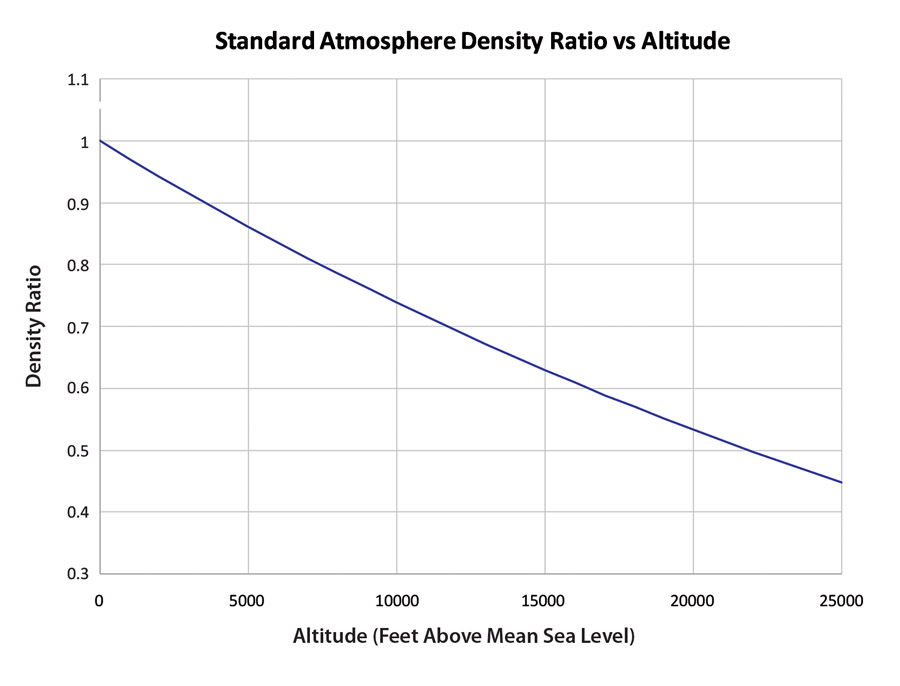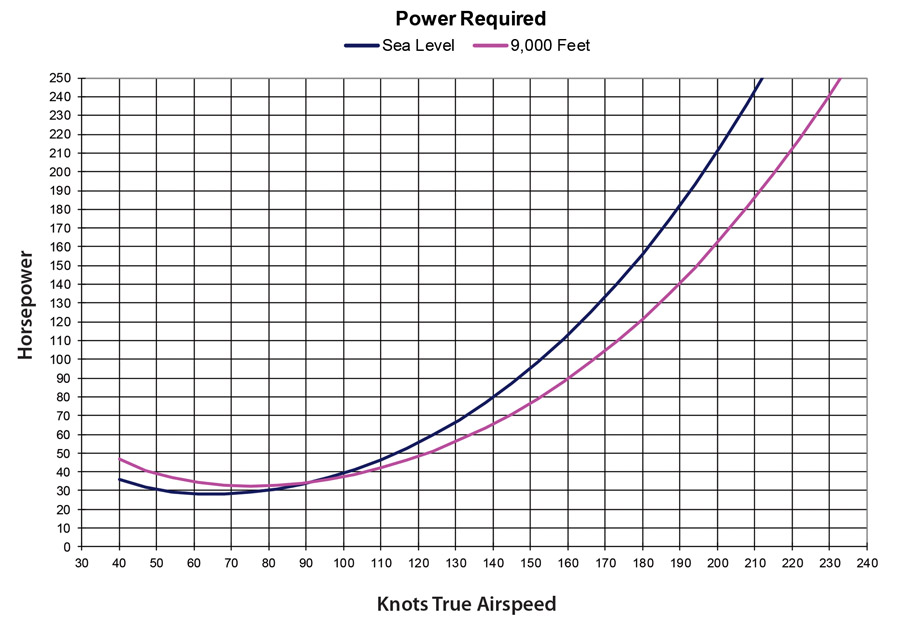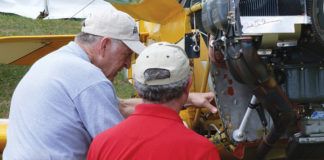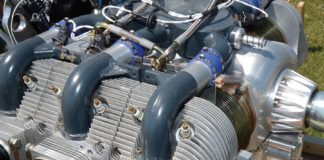In the November issue, we started our discussion of the design process with a look at the overall mission profile. Each phase of the mission affects the design of the airplane. The requirements the designer must work to in order to make a mission-capable airplane are partially chosen by whoever specifies the mission, and partially imposed by the constraints of physics, operating environment, and regulations.
Typically, the cruise phase is the most straightforward to specify. We need to define how high, how far, and how fast we want the airplane to fly. The cruise altitude, range, and speed determine a lot about the size and configuration of the airplane.
We will start with a look at how cruise altitude is determined, and how it might affect the overall design.
The Sea Level Standard Day Trap
The first thing a designer must clearly understand is that the design calculations and configuration choices must take into account the atmospheric conditions at cruise altitude. Of greatest concern is the variation of air density with altitude and air temperature.

Figure 1: As altitude increases, the density of the air drops. If the temperature is above standard, the density will be even lower than shown here.
As altitude increases, the density of the air drops. Figure 1 shows the density ratio (density/sea level density) for the atmosphere on a standard day. (In aerodynamic analysis, this ratio is represented by “σ”). If the temperature is above the standard temperature, the density will be even lower than shown here.
At any altitude above sea level, the density is less than that at sea level. Airplanes do not fly at sea level standard conditions unless you are sightseeing in Death Valley on a cook day. If you use sea level air density for your aerodynamic analysis, you will typically end up with an under-winged airplane with a poor rate of climb, and worse performance at cruising altitude than it would have if the wing was properly sized for actual cruise altitude.
Terrain
A primary concern for the designer is the terrain where the airplane will operate. In some parts of the world, the terrain is relatively flat, and the airplane will rarely have to climb above a few thousand feet msl to remain clear of the ground. This is not true everywhere, however. In the USA, East Coast and Midwest airplanes enjoy the luxury of relatively low, flat terrain in most places. In the West, and in Alaska, this is not the case, and there are large areas of mountainous terrain.
Performance
For typical general aviation airplanes, as altitude increases and air density drops, the cruise speed that the airplane will achieve at a given power setting increases. This is why it is desirable to fly at high altitude for fast, long-range cruise. Figure 2 shows the power required as a function of true airspeed for an example airplane flying at sea level, and at 9000 feet. Note that while the power required at a low airspeed is higher at high altitude, the power required at higher speeds is significantly lower at 9000 feet than at sea level.

Figure 2: Power required as a function of true airspeed at sea level and 9000 feet. Note that while the power required at a low airspeed is higher at high altitude, the power required at higher speeds is significantly lower at 9000 feet than at sea level.
Although the lower air density at higher altitude has a desirable effect on the power required to achieve a given speed, or the speed achieved with a given power, it has a detrimental effect of the ability of the engine to deliver that power.
To the first order, a piston engine operates at a constant volume flow of air. Each piston intake stroke pumps an amount of air equal to the displacement of that cylinder into the engine where it is mixed with fuel. The fuel/air mixture is then ignited to generate power. The amount of fuel each cycle can burn is determined by the amount of oxygen in the charge of air in the cylinder, and the amount of oxygen in that air is determined by the density of the air. As altitude increases, the air density, and hence the amount of oxygen available for combustion of the fuel, decreases.
On a standard day, at approximately 9500 feet altitude, the air density is 75% of sea level density (σ=0.75). Accordingly, a normally aspirated engine will produce 75% of rated power at wide-open throttle and rated rpm. This is why the optimum cruise altitude for airplanes with normally aspirated engines is between 8000 and 9500 feet. We typically specify cruise at 75% power. If we are willing to operate the engine at maximum rated rpm all the time, the theoretical optimum density altitude for cruise would be 9500 feet. In real-world operations we tend to want to cruise at a somewhat lower rpm, so the altitude at which the engine delivers 75% power is a little below 9500.
Above 9500 feet density altitude, a normally aspirated engine cannot deliver 75% rated power. The designer thus has a very important choice to make. If flying most of the time below 10,000 feet, and the speeds the airplane can achieve at those altitudes meet mission requirements, then a normally aspirated engine will work and is clearly more desirable from the viewpoints of cost, complexity, and maintenance.
If the mission requires the airplane to fly higher to either clear terrain or take advantage of the increase in cruise speed available at higher cruising altitudes, the designer is left with two choices. By far the most common approach is to use a turbocharged engine that employs an exhaust-driven supercharger to compress the induction air and provide the engine with air at higher pressure and density than the outside atmospheric pressure and density at altitude.
Another approach, which is very common with turbines and extremely rare with piston engines, is to use an engine that is thermodynamically capable of generating more than its rated power at sea level and then “flat-rate” it. A flat-rated engine is limited to a maximum torque or power output. Because it is thermodynamically capable of exceeding this at low altitude, it is operated at less than full throttle at low altitude. As altitude increases, the throttle is opened to keep the engine at its rated power until at some altitude well above sea level, the throttle is fully open and the engine is developing its flat-rated maximum power. At altitudes above this, the power output lapses proportionately with air density, like any normally aspirated engine.
Physiology
People need oxygen to function as much, or more, than engines. Most people live at relatively low altitudes and are not acclimated to the lower air density and lower oxygen available at higher altitudes. Above a certain altitude, people need supplemental oxygen to avoid hypoxia and remain cognitively functional. U.S. Federal Aviation Regulations specify requirements for supplemental oxygen use. FAR 91.211 specifies the following:
For cabin pressure altitudes between 12,500 feet and 14,000 feet, flight crew must use supplemental oxygen if the flight remains in this altitude range for more than 30 minutes.
For cabin pressure altitude above 14,000 feet but below 15,000 feet, flight crew must use supplemental oxygen at all times.
For cabin altitudes above 15,000 feet, all occupants of the airplane must use supplemental oxygen.
While it is possible to operate an unpressurised airplane at altitudes above 14,000 feet using supplemental oxygen as primary life support, most operators do not like to have to use continuous supplemental oxygen. Accordingly, if the airplane must operate routinely at these higher altitudes either for better cruise performance or to avoid high terrain, it is highly desirable for it to be pressurized to keep the cabin pressure altitude low enough to eliminate the need to use supplemental oxygen continuously.
Although pressurization can eliminate the need for continuous use of supplemental oxygen, an emergency oxygen system may be required to ensure safety in the event of a pressurization failure. FAR 91.211 requires that for any flight operations above 25,000 feet (FL250), a minimum of 10 minutes of emergency oxygen must be available for every occupant of the aircraft.
As we have seen, the choice of cruise altitude can have a major effect on the performance of the airplane and on the cost and complexity of its systems. Next time we will continue our consideration of the cruise (how high, how fast, how far) portion of the mission with a look at how cruise speed affects the design.

![]()
Barnaby Wainfan is a principal aerodynamics engineer for Northrop Grumman’s Advanced Design organization. A private pilot with single engine and glider ratings, Barnaby has been involved in the design of unconventional airplanes including canards, joined wings, flying wings and some too strange to fall into any known category.













